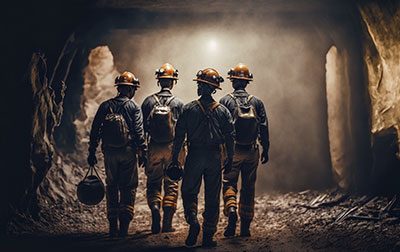Is aversion to change threatening the mining sector?

Two decades after the beginning of the largest commodities boom of the industrial era, the sector faces new challenges and opportunities, including:
- Increasing demands related to the decarbonization of the economy
- Societal opposition to mining activities
- More complex geological resources
- More sophisticated and challenging operations
- Lengthy and uncertain permitting processes
- Difficulty attracting and retaining talent
- Rising operating costs not offset by efficiency gains
- Need for new waste management solutions.
With this in mind, there are factors that add complexity and potential volatility to familiar and conventional processes.
- The mining sector is at the initial stage of the production chain, meaning it extracts raw materials directly from the earth. As a result, it does not rely heavily on other industries for its primary inputs. Unlike manufacturing sectors that depend on various components and technologies from upstream suppliers, mining primarily requires basic equipment and labor. While technology and innovation can enhance efficiency and safety, the core activities of mining—such as drilling, blasting, and hauling—remain relatively unchanged over time.
- Mining is inherently risky due to the nature of its operations, which involve heavy machinery, explosives, and working in hazardous environments. To mitigate these risks, the industry must implement stringent safety protocols and procedures. These processes are designed to protect workers from accidents and ensure safe operations. Compliance with safety regulations is crucial, as even minor deviations can lead to severe consequences, including injuries or fatalities. Continuous training and adherence to safety standards are essential to maintaining a safe working environment, creating a culture that’s adverse to even minor changes.
- The mining industry is characterized by its reliance on experienced professionals who possess specialized knowledge in geology, engineering, and mining operations. These experts play a critical role in navigating the complexities of mining, from exploration to extraction. Additionally, the sector deals with uncertain inputs, as the quantity and quality of mineral resources can vary significantly. Mine geomechanics, which involves understanding the behavior of rock and soil, adds another layer of complexity. The traditional nature of the industry, combined with these uncertainties, requires a deep understanding of the geological and operational factors that influence mining activities.
With these factors at the forefront, management models don’t often account for the change needed to meet current challenges. To mitigate this, organizations must focus their efforts on specific actions and key initiatives:
1. Stimulating a culture of innovation
Cultural change must be an internal priority, with innovation at the top of board agendas. It is essential to establish a specialized structure to encourage and develop business cases, responsibility for proof of concept, benefits, and best market practices.
2. Establishing strategic relationships with suppliers
Innovation is currently derived from effective collaboration with suppliers, while traditional procurement models are focused on standardizing proposals which are obstacles to innovation. Adopting flexible master service agreement contracts with strategic suppliers who invest in innovation is fundamental, and creating procurement processes that allow the development of proof of concept and reward innovation is crucial. This work must involve compliance and legal considerations.
3. Collaborating with startups and research centers
Supporting innovation hubs backed by companies, suppliers, and academia is an effective practice. Sharing practices, adopting open innovation, and accelerating the proof cycle are ways to foster a meaningful environment for innovation and reduce the sector’s traditional resistance toward change.
4. Developing flexible organizational structures
Promoting a more horizontal organizational framework, encouraging multidisciplinary teams, and being more receptive to executives with diverse experience improves quality and accelerates decision-making. Flexible organizational structures are also more attractive to potential talent and help retain high-potential professionals.
5. Establishing and communicating a vision for key transformational topics in the industry Responses to transformation can vary. Open-pit and underground operations, as well as those with different life-of-mine (LOM) expectations will have very different decarbonization strategies. It is crucial to establish and clearly articulate strategies for your company and your team. It is not imperative to have the most aggressive and innovative strategy in the sector, but it is essential to show stakeholders that there is a strategy aligned with your reality and society's demands.
Hatch has worked with organizations around the world to implement transformational practices, allowing clients in the mining sector to better position themselves to robustly face future challenges and increase their competitiveness in the global market. Contact us to find out how we’re partnering with clients to show them that their organizations will not only survive and thrive amid future changes, but that they can also lead the way in demonstrating effective, organizational transformation within the sector.
